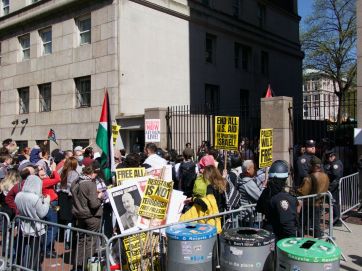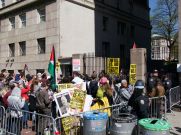When our civil libertarians get through with Guantanamo Bay, they might want to examine the case of the American Academy for Liberal Education, an organization that’s just been through the bureaucratic equivalent of water boarding. The AALE was suspected of nothing terroristic, though truth to tell, it has always, in its way, been subversive. The objects of its subversion are the confused understandings about the nature of liberal learning that have bloomed throughout higher education as it has transformed itself from a calling into an industry, understandings that now have more to do with mass and bulk, weights and measures, than the cultivation of a humanistic spirit. And it was precisely this subversion that prompted the AALE’s torments.
Two conceptions of academic purpose now live in uneasy tension. One, prized by the AALE, regards higher education as a civilizing experience, aimed at enlisting the learner in the process of human ascent, planting the seeds of wonder about life’s majesty, and instilling a reverence for the heights of cultural achievement. At best, the learner becomes equipped to assume an active role in furthering humanity’s climb, at the least, he or she is left with a supportive sense of its overall value. These are somewhat intangible goals, their attainment not easily captured by standardized metrics. Testable factual knowledge certainly figures in their assessment, but so do the kinds of subtler judgments that have traditionally been expected from gifted and dedicated teachers. This may, by its nature, not be an education for the many. But some must receive it if civilization is to proceed.
The other conception views higher education as the last link in a supply chain delivering concrete product. The product in its preliminary stages can be elementary cognitive skills, and later on, more advanced and professional ones, but at each step it has the quality of palpable familiarity, representing some fairly known state of a practical art. This type of education – though instruction might be the better term – is nothing to be sneered at. It makes the wheels of commerce turn, providing the foundation on which more rarified accomplishment rests. Millions seek it, but not as a calling to liberal study. It is, as the supply chain metaphor suggests, an industrial pursuit, and its means of quality control can be, when volume of output is desired, effectively mechanized without too much being lost.
In the contemporary academy the calling has very nearly been swamped by the industry, not surprisingly in view of the latter’s cash cow promise. In part, this is reflected in the withering of liberal education as a set of meaningful curriculum requirements, or a major item of university investment. But it is also manifested in the imposition of industrial methods on what of liberal education remains, “massifying” it in a manner that destroys its unique spirit: Huge lecture sections, the use of undertrained adjuncts, short answers instead of essay questions, etc., etc., all by now commonplace practice.
The AALE was set up in 1992 (with some help from the NAS) to act as a guardian for the integrity of such genuine liberal arts programming as had survived. Its object was to accredit colleges that continued to put strong emphasis on liberal learning, as well as individual programs within institutions that did the same. Its growth was not spectacular. Given the environment in which the AALE operated it could hardly have been so, but it was fairly steady, indicating a recognition that its accolades had some persisting market value. What nearly tripped it up, after more than ten years of such modest but useful success, was the migration of the industrial model up from general practice into regulatory insistence, the hallmark of the approach to reform adopted by the U.S. Department of Education under Margaret Spellings.
Accreditation is regulated by the Department of Education. Only accreditation by accreditors who have the department’s approval entitles a college’s or university’s students to receive federal aid. For all intents and purposes, therefore, endorsement by the department is a requisite to operate as an accreditor. Moreover, departmental recognition must be reviewed periodically, normally at five year intervals, each review constituting an inquiry into whether or not the accreditor has the resources and procedures to undertake its work competently. The AALE won recognition early in the Clinton Administration and had no trouble winning renewals until the shifts in departmental policy initiated by Spellings.
Under Spellings the department’s idée fixe has been the need to develop measures of academic outcome which the public can utilize to judge the value-added of any college’s or university’s “product” – a reasonable notion for some educational purposes, particularly those where students are mainly interested in future earning power. Thus test scores, retention figures, graduate employment statistics, etc., etc., might be marshaled in some standardized way to ensure transparency and comparability in evaluation. Not satisfied, however, with just talking up this concept, though talk of it there was aplenty, the department seized upon the accreditors as the logical enforcement mechanisms, a stratagem that preserved some semblance of self-regulation, but kept itself, through its accreditation reviews, in the ultimate driver’s seat.
While the accreditors and higher education organizations were willing to talk, the high pressure approach was poorly received, most failing to see where even the statutory authority for this full court press came from. Congress expressed its umbrage as well, meditating whether or not to legislate away the department’s new regulatory claims.
But apart from the heat generated by this Washington rumpus, there were a variety of other more mundane limitations on what the department could actually do to get the results it desired. The biggest hindrance derived from the structure of the accreditation business. The largest and most consequential accreditors, the six so-called “regionals”, were virtual monopolies within their respective areas. Withdrawing recognition from any one of them would thus thrust hundreds of colleges and universities into an existential crisis, depriving their students of eligibility for federal aid. Yet there was a ray of sunlight. There was also an accreditor of very modest size, many of whose affiliated institutions had dual accreditation, and so were not wholly dependent on its survival: the American Academy for Liberal Education. Its disappearance might hardly make a stir. What’s more, the AALE’s president had been out in front in resisting the supply chain paradigm, and so could be made an example that might serve to “encourage the others.” No one ever expects the Spanish Inquisition, but in this case it truly knocked at the AALE’s door.
What ensued was eighteen months of bureaucratic torment. On the heels of a recommendation by its accreditation advisory panel, a body known as NACIQI (National Advisory Committee on Institutional Quality and Integrity), the Department of Education on April 2007put the AALE under an accreditation “hold”, making it impossible for additional institutions to be brought under its aegis. This promptly scared away a number of colleges already there, cutting badly into the AALE’s dues-dependent cash flow. Despite the AALE’s efforts to do all it could do, without compromising its special mission, to comply with the department’s repeated demands for evidence that it took outcomes assessment seriously, it never seemed to be able to do enough. As the months dragged on, the AALE came within a hairsbreadth of going belly up.
Fortunately its friends’ protests began to have some impact. Last December NACQI overruled departmental staffers who had recommended that the hold continue, a course which would certainly have proved the AALE’s death sentence. Instead, it recommended that the hold be lifted and the AALE’s recognition be restored for a single year. Even this, however, represented a dire judgment, in that it would have required the AALE to invest its depleted resources in engaging in yet more compliance reviews, rather than freeing them up for its real work. Fortunately, the Assistant Secretary for Post-Secondary Education, Diane Auer Jones, on appeal, advised that a full five year renewal of recognition be granted. But just as relief seemed at hand the melodrama took yet another doleful turn with Jones suddenly resigning when higher-ups resisted her recommendation. Once more the supporters of the AALE waited with baited breaths as months dragged by. And then on July 22… cry a reprieve! Secretary Spellings announced her final determination, the hold would indeed be lifted and recognition extended – not for five, and not for one, but for a split difference interval of three years. If the AALE had not quite reached the sunlit uplands, it at least had been delivered from the valley of the shadow. Its work could begin anew.
What’s to be learned from this story of narrow escape? First that even an idea having some merit, fast loses it when enforced in a centralized and zealous way. Basic principles of fairness, such as non-discrimination, would be an exception to this rule, but, for the most part, the great strength of American institutions in general, and American higher education in particular, lies in a pluralism which demands respect. Instead of trying to whip them into a line, the Department of Education would have been better advised to encourage colleges and universities to exploit diverse market niches by breaking up the near monopoly over accreditation now held by the regionals. Competition among accreditors would allow consumers to distinguish between academic approaches in a way that the current one-size-fits-all region-based system obscures. Colleges and universities could then craft more individualized profiles in confidence that academic consumers could accurately discern them Under such a regime, the AALE would become one of many accrediting signposts conveying real and distinct information.
More important, educators must begin to tease apart the tangle of goals, clashing when not utterly contrary, that their institutions now pursue. So long as these remain conceptually knotted, the ones commanding the most in time and money can easily create an ambiance intellectually toxic to those more modest in scale but refined in aspiration. This is not to condemn the giant activities, only the careless frame of mind that sometimes accompanies them. And not only federal officials fall into this trap. On campus after campus, academic executives fail to see the need for the only kind of academic diversity that genuinely counts, the type that exemplifies the many different functions and perspectives an institution of higher learning necessarily embodies. In coming through its ordeal one can hope that the AALE has not only saved its skin, but served to remind the rest of academe, contra Ben Franklin, that hanging separately may be a better fate than to be roped in a single noose.













